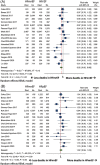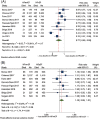Long-term mortality in heart failure with mid-range ejection fraction: systematic review and meta-analysis
- PMID: 36045010
- PMCID: PMC9773707
- DOI: 10.1002/ehf2.14125
Long-term mortality in heart failure with mid-range ejection fraction: systematic review and meta-analysis
Abstract
Aims: Heart failure patients with mid-range ejection fraction (HFmrEF) have overlapping clinical features, compared with patients with reduced ejection fraction (HFrEF) and preserved ejection fraction (HFpEF). We aim to perform a meta-analysis of studies reporting long-term outcomes in HFmrEF compared with HFrEF and HFpEF.
Methods and results: Data from 18 eligible large-scale studies including 126 239 patients were pooled. Patients with HFmrEF had a lower risk of all-cause death than those with HFrEF [risk ratio (RR) = 0.92; 95% CI = 0.85-0.98; P < 0.001]. This significant difference was seen in the follow-up at 1, 2, and 3 years. Patients with HFmrEF had significantly lower risk of cardiovascular (CV) deaths than HFrEF (RR = 0.77; 95% CI = 0.65-0.92; P < 0.001). Subgroup analysis showed that studies recruiting >50% of males had higher risk of deaths with HFrEF (RR = 1.15; 95% CI = 1.04-1.26; P = 0.006). When compared with HFpEF, patients with HFmrEF had comparable risk of all-cause death (RR = 1.02; 95% CI = 0.96-1.09; P = 0.53). Similarly, there were no differences in the 1, 2, and 3 year deaths; CV and non-CV deaths were insignificant between HFmrEF and HFpEF.
Conclusions: The results of the study support that HFmrEF has better prognosis than HFrEF but similar prognosis when compared with HFpEF. Gender disparity between studies seems to influence the results between HFmrEF and HFrEF. Transition in left ventricular ejection fraction (LVEF), which could not be addressed in the study, may play a decisive role in determining outcomes. PROSPERO review registration number CRD42021277107.
Keywords: Gender differences; Heart failure; Meta-analysis; Mid-range ejection fraction; Mortality; Systematic review.
© 2022 The Authors. ESC Heart Failure published by John Wiley & Sons Ltd on behalf of European Society of Cardiology.
Conflict of interest statement
Dr Sanders reports having served on the advisory board of Medtronic, Abbott Medical, Boston Scientific, CathRx and PaceMate. Dr Sanders reports that the University of Adelaide has received on his behalf lecture and/or consulting fees from Medtronic, Abbott Medical, and Boston Scientific. Dr Sanders reports that the University of Adelaide has received on his behalf research funding from Medtronic, Abbott Medical, Boston Scientific, BD, and Microport. All other authors have no disclosures. Dr Pathak reports having served on the advisory board of Medtronic, Abbott Medical, Boston Scientific. Dr Pathak reports that Canberra Heart Rhythm Foundation has received on his behalf lecture and/or consulting fees from Medtronic, Abbott Medical, Boston Scientific and Biotronik. Dr Pathak reports that Canberra Heart Rhythm Foundation has received on his behalf research funding from Medtronic, Abbott Medical, Boston Scientific, and Biotronik.
Figures





References
-
- Ammar KA, Jacobsen SJ, Mahoney DW, Kors JA, Redfield MM, Burnett JC Jr, Rodeheffer RJ. Prevalence and prognostic significance of heart failure stages: Application of the American College of Cardiology/American Heart Association heart failure staging criteria in the community. Circulation. 2007; 115: 1563–1570. - PubMed
-
- Solomon SD, Anavekar N, Skali H, McMurray JJ, Swedberg K, Yusuf S, Granger CB, Michelson EL, Wang D, Pocock S, Pfeffer MA. Candesartan in heart failure reduction in mortality I. influence of ejection fraction on cardiovascular outcomes in a broad spectrum of heart failure patients. Circulation. 2005; 112: 3738–3744. - PubMed
-
- Bonsu KO, Owusu IK, Buabeng KO, Reidpath DD, Kadirvelu A. Clinical characteristics and prognosis of patients admitted for heart failure: A 5‐year retrospective study of African patients. Int J Cardiol. 2017; 238: 128–135. - PubMed
-
- Cheng RK, Cox M, Neely ML, Heidenreich PA, Bhatt DL, Eapen ZJ, Hernandez AF, Butler J, Yancy CW, Fonarow GC. Outcomes in patients with heart failure with preserved, borderline, and reduced ejection fraction in the Medicare population. Am Heart J. 2014; 168: 721–730. - PubMed
Publication types
MeSH terms
LinkOut - more resources
Full Text Sources
Medical

